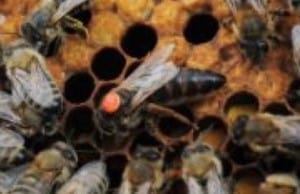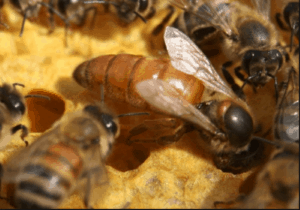As we all probably know, honey bees are a collective species. They live in colonies that bring together tens of thousands of individuals. Every honey bee within the colony is important, and they all have their specific roles. However, no other bee is as important for the life of the colony as the queen. While there are thousands of worker bees in every colony and often hundreds of drones, there can ever be only one queen bee.
So, why do beekeepers color dot their queens? Placing a colored dot on the thorax of the queen makes it much easier to find and identify the queen at any given time. Since the presence of a healthy queen is crucial for the well-being of the colony, beekeepers need to be aware of what is going on with the queen at all times.

The queen bee does have a variety of features that allow beekeepers to distinguish between the queen and worker bees, but when working with thousands of bees within the hive it can be quite difficult to identify the queen and a color dot makes this much easier. Additionally, a specific color is used each year for the queen bee color dots, so the mark can tell the beekeeper the birth year of the queen.
Having answered this basic question, one could move on to ask more specific questions like, for example, why is it so important to the beekeeper to be able to identify the queen? In fact, there are many situations where these color dots come in quite handy. Keep reading if you’re interested in learning what they are and also how to properly mark a queen bee.
Table of Contents
Why Do Beekeepers Need To Mark The Queens?
As we have mentioned, the beekeepers mark the queens with colored dots because this practice makes it much easier to find the queen amongst thousands of worker bees. But why is it so important to be able to find the queen? While the majority of the bees within a colony are female, most of them are worker bees – female bees that don’t have a fully developed reproductive system, that is. While worker bees do most of the work around the hive, laying eggs is solely the responsibility of the queen. Because of this, the queen is usually the mother of most, if not all, bees in a colony.
The queen bee also constantly releases specific pheromones that affect the behavior of all the bees within a hive. Because of these pheromones, all of the bees in a colony know when there is a healthy queen present. If the queen is gone, the worker bees would be immediately aware of it and the queen will need to be replaced. For more information on signalling pheromones, please see our other article: https://schoolofbees.com/can-bees-call-for-help/.
Just like the worker bees know everything is fine and well if they have a healthy queen, the beekeeper can also benefit from this information. By simply marking the queen with a colored dot, it becomes much easier for the beekeeper to keep track of the queen. Moreover, since a specific color is chosen each year, the beekeeper can easily tell when (or if) queen replacement occurs.
How To Mark A Queen Bee?
Queen bees are always marked by placing a dot of colored paint on the thorax of the bee. The thorax is actually the back of the bee, just between her wings. In this way, the colored dot is in a place that is easily seen by the beekeeper, but it doesn’t cause any problems to the queen bee. With that being said, the colored dot should always be fairly small, and the beekeeper needs to be careful not to apply the paint to any part of the bee other than her thorax, such as her wings, as this might hurt her and make it difficult to move.
Even though marking a queen bee is a fairly simple process, there are a couple of things that should be taken into consideration while doing it. First of all, of course, the beekeeper needs to be able to find and identify the queen among the worker bees in the hive. How is this done exactly? Let’s see!
How To Find And Identify A Queen Bee?
The queen bee actually starts out as an egg that is completely the same as that of the worker bees. However, the differences start developing once the egg destined to become a queen is put in a special cell and fed only royal jelly. The royal jelly died causes the queen bee to developed some physical characteristics that are different from those of the worker bees. First of all, the queen is usually the largest bee in the colony. The drones can also be quite large, though, but the queen is usually longer and narrower than any other bee in the hive.
Interested in the wings? Then also this other article: https://schoolofbees.com/do-queen-bees-have-wings/.
Furthermore, the queen bee has a more pointed abdomen than the worker bees whose abdomen is quite round. Finally, drones and worker bees always keep their legs under their bodies, so if you are looking at the bee from above you can’t see the legs. On the other hand, the queen bee will usually have her legs spread outwards to the sides.

Besides physical characteristics, understanding the specific behavior of the queen bee and the worker bees surrounding can also be helpful in identifying the queen. First of all, the queen can usually be found deep inside the hive, and not on the surface. Additionally, it helps to look for any unusual behavior of the worker bees inside the hive. When the queen moves around, the worker bees tend to cluster and move out of the way, thus making it much easier for the beekeeper to notice the queen.
How To Hold A Queen Bee?
Once the beekeeper finds the queen, he will need to hold her up in order to place the colored dot on her thorax. The queen should be picked up with extreme care. You can hold her between two fingers by her thorax or even by her wings, but again, this needs to be done very gently in order not to harm the queen.
If you are worried that the queen bee might sting you, you are right. However, the queen’s sting is actually usually less painful than the sting of the worker bee. While the worker bees have barbed stings, the sting of the queen bee isn’t barbed, which means she will not die when she stings the enemy.
Finally, it is advisable to hold the queen over the hive the whole time you are doing the marking. It’s better for her if she falls back inside the hive than to fall outside on the ground as this can cause unnecessary stress to the very valuable queen bee.
What Kind Of Paint Can Be Used To Mark A Queen Bee?
In general, honey bees don’t have problems with any type of paint used for marking. What’s more important is to not use too much paint and to let the paint dry completely before releasing the bee. With that being said, any type of acrylic paint is generally fine to use. Many beekeepers use model car paint or POSCA paint pens, but you can also buy markers made specifically for the purpose of marking queen bees or even stick-on dots.
Which Color Should I Use To Mark The Queen Bee?
| Year Ending Number | Queen Bee Colour |
| 1 or 6 | White |
| 2 or 7 | Yellow |
| 3 or 8 | Red |
| 4 or 9 | Green |
| 5 or 0 | Blue |
There is a simple code used by all beekeepers across the world that allows everyone the year of birth of the queen. It’s actually quite simple: white paint is used for year ending in 1 and 6, yellow paint is used for years ending in 2 and 7, red paint is used for years ending in 3 and 8, green paint is used for years ending in 4 and 9, and blue is used for years ending in 5 and 0. Therefore, the queen bee marking color for 2019 is green, while in 2018 it was red, for example.
When Is The Right Time To Mark A Queen Bee?
Queen bees can be marked with colored dots at any time, but the easiest time is certainly before she is introduced to the hive. The best time to find a queen that is already in the colony is definitely the spring, but this is simply because at this time there are fewer bees inside the hive, thus making it easier to identify the queen.
Related Questions
Do queen bees sting?
Yes, queen bees are able to sting if facing danger, but unlike worker bees, they will not die after stinging and can repeat it multiple times. This is because the stings of queen bees are not barbed like those of the worker bees, so the sting does not get stuck in the skin of the enemy.
What happens when a queen bee dies?
A colony of honey bees always needs to have a healthy queen, so when a queen bee dies, the colony will be upset and the worker bees will start working on producing a new queen if that is possible. This is done by taking an egg that is less than 3 days old and placing in a special queen cell and feeding it royal jelly. After only 8 days, the queen larva will be ready to emerge.
See these other articles for more information on what happens with dead bees: https://schoolofbees.com/do-dead-bees-attract-more-bees/ and https://schoolofbees.com/can-bees-and-wasp-sting-when-they-are-dead/.
